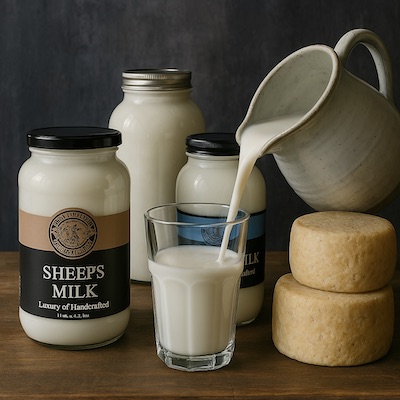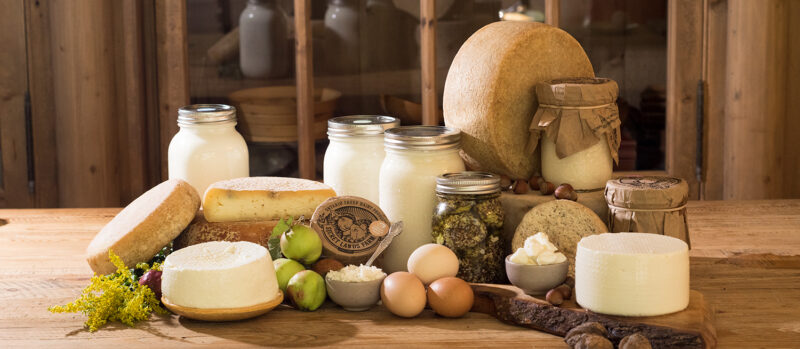Cheese is one of the world’s most diverse foods: some sources estimate over 2,000 named cheeses globally. That vast variety spans every corner of the globe and every flavor you can imagine. At Secret Lands Farm, we celebrate this diversity. We craft many different cheeses on our family sheep farm and love helping people explore cheese. In this article we’ll take you on a tasty tour: from why cheeses have unusual names, to the two main “families” of cheese, to how cheese texture and milk type shape flavor. We’ll also share why unfamiliar cheese names shouldn’t scare you – often they’re just cousins of cheeses you already enjoy. Finally, we’ll point out some of our own sheep’s‑milk cheeses as delicious examples, with links so you can taste them yourself.
Thousands of Cheeses, One Delicious World
With roughly 2,000+ types of cheese in existence, it helps to break them into groups. People often categorize cheese by region of origin, milk type, aging style, or texture. For example, many classic European cheeses are named for their birthplace. Cheddar comes from Cheddar (Somerset, England); Brie is named for the Brie region of France; and Gouda takes its name from the Dutch city of Gouda. (These names highlight history – for centuries, cheese was made and sold locally.) Sometimes cheese names refer to the milk or recipe. For instance, the Italian word pecorino comes from pecora meaning “sheep”, and caprino from capra meaning “goat”, reflecting the animal’s milk in the cheese. Even words like “double crème” tell you something – they mean extra cream was added. In short, cheese names are like stories: they can tell you the region, milk source, or technique behind the cheese.
- Regional names: Cheddar (England), Camembert (Normandy), Gorgonzola (Italy), Oaxaca (Mexico).
- Milk types: Pecorino (sheep’s milk), Caprino (goat’s milk), Buffalo Mozzarella (buffalo’s milk).
- Style/Texture descriptors: “Soft-ripened” (like Brie), “blue” (stinky molds), “washed-rind” (stinky bregar), or fat content terms like double-crème and triple-crème – the latter means a very rich Brie with 60–75% butterfat.
Names might sound exotic, but they carry clues. For example, “Buffalo Mozzarella” tells you it was made with buffalo milk; “Triple Crème Brie” means we’ve added extra cream and it’s very indulgent. Learning the naming logic makes cheese less mysterious – and more fun to try.
Cheese Families: Fresh vs. Aged
Behind all these varieties, cheeses fall into two main families: fresh (unaged) cheeses and aged (ripened) cheeses. Fresh cheeses are made and eaten young, often within days of production. They have very high moisture and mild flavor. Aged cheeses spend weeks or years maturing, developing deeper, sharper flavors and firmer textures.
Fresh cheeses are unaged, soft, and milky. They are usually made the same day and eaten right away. Think cottage cheese, ricotta, cream cheese, quesillo (Latin American string cheese), chèvre (fresh goat cheese), and similar. These are often spreadable or soft enough to crumble. For example, our farm’s own Sheep’s Milk Ricotta is a fresh whey cheese – silky, mild, and creamy. Fresh cheeses like these have a very high moisture content and a light, lactic tang. They are not aged on purpose, so their flavors stay delicate. You’ll often see them on breakfast plates or in sandwiches (cream cheese) and desserts (ricotta), since their mildness makes them very versatile.
In contrast, aged cheeses are firmer and flavor-packed. During aging, moisture gradually escapes, and natural cultures transform the flavor. Many famous cheeses – Parmesan, Cheddar, Gouda, Manchego, Comté, aged cheddars, Pecorino – are made this way. Their textures range from semi-soft to crumbly hard, depending on age. For example, our Limited Edition Pecorino has been aged for years into a sharp, nutty hard cheese (imagine Italian Parm-like flavor with sheep’s milk richness). Long aging concentrates flavor: a mild curd can become sharp, tangy, even spicy. One rule of thumb is that hard cheeses are aged longer until much of the moisture is gone. (Parmesan and Pecorino are pressed tightly and aged for a year or more, leaving them low-moisture and crumbly.) So when you see an aged cheese on the shelf, expect a firmer bite and a bolder taste.
Fresh Cheeses: Soft, Fresh & Flavorful
Fresh cheeses are our day job here at the farm, and they show why “fresh” cheeses are a family of their own. By definition, these have no rind or mold and are eaten very soon after making. Many cultures have a version of fresh cheese – Mexican queso fresco, Middle Eastern labneh, Indian paneer, Greek feta (often brined fresh), etc. All these belong to the fresh family.
- For example, cottage cheese and cream cheese (like our Sheep’s Milk Cottage Cheese) are pure fresh cheese. They’re soft-curd cheeses with gentle, milky flavor. We sell our Sheep’s Milk Cottage Cheese at the farm – it’s creamy, slightly tangy, and perfect on a bagel or salad.
- Ricotta is a classic fresh whey cheese (our own Sheep’s Milk Ricotta). It’s smooth and delicate, great in lasagna or stuffed pastas.
- Labneh and chèvre (fresh goat cheese) are fresh and soft – in fact, chèvre just means goat cheese, and it’s usually sold fresh as a log or spread.
- Fresh halloumi (from Cyprus) is brined but not aged. Even though it’s somewhat firm and can be grilled, it’s still a “fresh” cheese by aging standards because it isn’t ripened with mold. (You’ll notice our halloumi is called “semi-soft” on our site because it can be eaten young, even grilled.)
Fresh cheeses tend to be very mild, milky, and moist. Many of them are white or pale because there’s no maturation. They’re often used in cooking where you want a gentle creaminess (think ricotta in cannoli or mozzarella in Caprese salad). And, because they have high moisture, they must be kept chilled and don’t last long (usually a week or two).
Aged Cheeses: Firm, Nutty & Complex
The aged family is all about time and transformation. Once a cheese is formed into a wheel or block, it’s set aside to age. During this period, bacteria or molds work on the cheese, moisture evaporates, and the flavors and textures change dramatically.
Aged cheeses cover a wide range. On the soft end are soft-ripened cheeses like Brie and Camembert: they start relatively firm but mature into a runny, creamy interior under a white bloomy rind. (Our farm’s Tommette de Brebis is a Basque-style soft-ripened sheep cheese – aged a couple of months into a richly flavored semi-soft wheel.) In the middle are semi-soft/sem-firm cheeses like Havarti, Fontina, Munster, Gouda (young), Edam – cheeses that retain more moisture and elasticity. Then come semi-hard cheeses (Cheddar, young Gouda, Emmental), which are firmer and often sliced. Finally, the hard cheeses (Parmesan, dry Jack, aged Pecorino) have been aged the longest until they are very dry and crumbly.
To illustrate, think of cheddar: it starts mild, but extra sharp cheddar is just an older cheddar – the same recipe aged longer, so it dries out and sharpens in flavor. Parmesan (Parmigiano) is literally aged two to three years; without that aging, it would be bland. In our case, aging our sheep’s milk Pecorino for months gives it a salty, nutty punch that you wouldn’t get from a fresh cheese.
Key point: Aging reduces moisture. A good rule is that hard cheeses have less than ~50% moisture by weight, achieved by long aging and pressing. This makes them very firm (sometimes granular in texture). Cheddar, Gouda, and Swiss become firmer with age, too. On the flip side, fresh cheeses are mostly water (hence soft), so they can never become hard unless aged. That’s why we often talk about texture categories next.
Cheese by Texture: Soft, Semi-Soft, Semi-Hard & Hard
One easy way to understand all cheeses (fresh or aged) is by texture/firmness, which is mainly about moisture content. In general:
- Soft cheeses are high-moisture, easily spreadable. This group includes fresh cheeses and many soft-ripened cheeses (Brie, Camembert). Many soft cheeses can’t really be sliced cleanly. Examples: Cream cheese, cottage cheese, queso fresco, fresh mozzarella, and feta (though feta is often brined). Even young chèvre (goat log) falls here. Soft-ripened Brie or Camembert is also “soft” when ripe (gooey inside).
- Semi-soft cheeses have a bit less moisture. They might be sliced and can be mild to pungent. Think Havarti, Monterey Jack, Muenster, Fontina, Colby. (Halloumi is listed as semi-soft on our site, since it’s firmer yet not aged.) These often melt well or are suitable for sandwiches.
- Semi-hard cheeses have a firmer texture and more flavor. Classic examples: Cheddar, Gouda, Edam, Swiss (Emmental), Gruyère, Jarlsberg. These have been aged longer; they slice or shred cleanly and have a pronounced flavor. For instance, a young Gouda is semi-soft, but a mature Gouda (aged 1–2 years) becomes semi-hard, nutty, and crumbly.
- Hard cheeses are aged until very dry and crumbly. Parmesan (Parmigiano-Reggiano), Pecorino Romano, aged Manchego, dry jack – these lose most of their moisture. You grate or shave them. Hard cheeses usually have intense flavor and a gritty, crystal-like texture. Parmesan is a prime example: it spends so long aging that only ~30-35% of its original moisture remains.
These texture categories cut across the fresh/aged divide. For example, fresh feta (if eaten right away) is soft, whereas aged feta (if left out in brine) becomes firmer. Our halloumi is a “fresh” cheese but firm enough to grill, so it’s called semi-soft. Likewise, fresh chèvre is very soft, but if aged into goat Gouda it would be semi-hard. The Wisconsin Cheeseman notes that “fresh cheeses are unaged and have high moisture content”, while hard cheeses are pressed and aged until moisture is under half their weight. In practice, if you put two cheeses side by side, you can often tell soft vs hard by touch or a knife.
Examples of categories:
- Soft: Brie, Camembert; Fresh ricotta, cream cheese, labneh; Feta (young); Sheep’s Milk Ricotta, Sheep’s Milk Cottage Cheese.
- Semi-soft: Havarti, Muenster, young Gouda; Mozzarella; Halloumi.
- Semi-hard: Cheddar, Swiss, Gouda, Edam; Jack. (Our aged Gouda is here.)
- Hard: Parmesan, aged Pecorino, aged Manchego, dry Jack; Pecorino Limited Edition.
Milks Matter: Cow, Goat, Sheep & Buffalo
The type of animal milk used makes a big difference in flavor and feel, even if the cheese recipe is the same. Briefly:
- Cow’s milk: The most common. Cheeses from cow’s milk (like most Cheddars, Swiss, Gouda) tend to be buttery, sweet, and grassy if the cows grazed well. Depending on breed and feed, you might taste hints of caramel, nuts or mushrooms. (For example, good Alpine cheeses often taste “grassy” because of mountain hay.) Cow’s milk cheeses have moderate fat and tend toward mild flavors unless aged a long time.
- Goat’s milk: Goat cheeses (chèvre) are famous for a bright tang. Fresh goat cheese often tastes citrusy or “tart,” and is paper-white because goat milk doesn’t turn yellow (no beta-carotene). A Saxelby Cheese report notes: “Goat’s milk cheeses often come off as lemony, mineral or even barnyardy”. Soft goat cheeses (logs, spreads) are tangy and sharp. Aged goat cheeses mellow into nutty, earthier flavors but still keep a tang.
- Sheep’s milk: Our specialty! Sheep’s milk is richer and fattier than cow or goat milk. Cheeses from sheep’s milk (like Manchego, Pecorino, Roquefort) are often extra creamy, rich, and flavorful. According to the Cheese Baron, sheep’s milk has the highest fat content of the big three milks, giving a velvety body. The flavor notes in sheep cheese can include sweet cream, dried fruit, honey, and even a hint of lanolin (wool oil). For example, a young sheep cheese might taste sweet and milky, while an aged one will be tangy and complex. Our sheep’s milk cheeses carry that natural richness – even simple fresh sheep cheeses have more creaminess and protein than the cow-milk versions.
- Buffalo milk: Water buffalo milk (like for Mozzarella di Bufala) is super-rich – it can have higher fat and protein than cow’s milk. The result is ultra-creamy, tender cheese. Buffalo mozzarella is prized for being extra rich and moist. (In India and parts of Asia, buffalo milk cheeses like paneer also benefit from this richness.)
In short, the type of milk = the type of taste. Saxelby Cheese sums it up: cow’s milk gives grassy, nutty notes, goat’s milk gives tangy citrus/earthy notes, and sheep’s milk gives the sweetest, richest profile. So even using the same recipe, simply switching from cow to sheep milk would change the outcome. It’s like cooking – swapping olive oil for butter can change the flavor.
On our farm, all our cheeses are made from sheep’s milk. That means you’ll notice a consistent richness in everything we make. A sheep’s milk ricotta or feta is denser and silkier than a cow’s version, for example. But it also means we love trying others: we sometimes sample a goat’s feta or buffalo mozzarella just to taste the difference – and it’s always interesting!
Cheese Cousins: Embrace the Variety
With thousands of cheeses, it’s natural to feel shy about a new name on a menu. But don’t worry – many obscure-sounding cheeses are just close cousins of familiar ones. Once you know the basics, you can navigate any cheese counter.
Think of it this way: cheeses come in “families” by style. For example, all soft-ripened cheeses are similar in texture (gooey interior, bloomy rind). So if you like Brie, you’ll probably like Camembert, Neufchâtel, and Ossau-Iraty (a Basque sheep’s cheese). Our Tommette de Brebis (Basque Tomme) is a sheep’s milk soft-ripened cheese that shares a lot with Brie – rich, creamy, and slightly funky. Try it like you would Brie or Camembert on a cheese board. Likewise, blue cheeses (Stilton, Roquefort, Cabrales) all have that distinctive blue mold tang – if you love one, the others will feel in the same family.
Or take firm sheep’s milk cheeses: Pecorino from Italy and Manchego from Spain are like cousins. Both are pressed sheep cheeses that are nutty and salty; Manchego is just a younger, milder relative of Pecorino Romano. In fact, the word Romano cheese you see in North America comes from “Pecorino Romano” – just like Parmesan comes from Parma. So a slice of Pecorino Limited Edition from our farm is basically a sheep’s-milk Parmesan; grate it on pasta like you would Parm.
Cheese Names vs. Cheese Styles
Even American-style cheeses have exotic names. Colby and Monterey Jack are “original American” semi-hard cheeses named after Colby, Wisconsin and Monterey, California – but they’re basically cousins of Cheddar and Edam. “American cheese” you see on burgers is just processed cheese (often cow milk Cheddar) with a nod to its U.S. origins.
The bottom line: focus on style, not name. If you know you like creamy goat cheese or tangy Swiss, then a cheese with an unfamiliar name in that style is worth a try. For example, you might never have tried cottage cheese with sheep’s milk – ours is fresh and slightly tart – but it belongs to the same “soft curd” family. Or our aged Caciotta is a washed-rind cheese that might remind you of French Pont-l’Évêque. So go ahead: try that strange-looking cheese on the cheese counter. If you like one sheep’s-milk hard cheese, you’ll probably like another. They’re all cousins on the flavor family tree!
Conclusion: Taste, Explore, Enjoy
We’ve barely scratched the surface of the cheese world, but we hope this guide makes it less confusing and more delicious. At Secret Lands Farm, we’re passionate about sharing our cheeses (and knowledge!) with you. Whether you prefer fresh and mild or aged and bold, there’s a sheep’s-milk cheese (or several!) waiting for you here. We invite you to taste for yourself: browse our selections like Sheep’s Milk Ricotta (fresh and dreamy) or Pecorino Limited Edition (aged and savory) on our website. You can shop online or come visit the farm for a tasting.
No need to fear those foreign names – behind every label is a flavor story. As long as you start with what you know and build from there, you’ll find many “new” cheeses feel familiar. We encourage you to be adventurous: grab that goat log, that sheep wheel, or that buffalo mozzar-ella (see what we did there?) and enjoy.
Come explore at secretlands.ca or drop by our farm store. We can’t wait to share our farm-to-table cheeses with you. Your next favorite cheese may be just waiting to be discovered!




